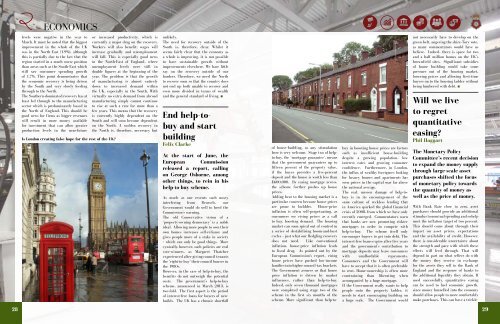The Future of Britain
Create successful ePaper yourself
Turn your PDF publications into a flip-book with our unique Google optimized e-Paper software.
ECONOMICS<br />
levels were negative in the year to<br />
March. It must be noted that the biggest<br />
improvement in the whole <strong>of</strong> the UK<br />
was in the North-East (1.9%), although<br />
this is partially due to the fact that the<br />
region started in a much worse position<br />
than areas such as the South-East which<br />
still saw consumer spending growth<br />
<strong>of</strong> 1.7%. This point demonstrates that<br />
the economic recovery is being driven<br />
by the South and very slowly feeding<br />
through to the North.<br />
<strong>The</strong> Southern-dominated recovery has at<br />
least fed through to the manufacturing<br />
sector which is predominantly based in<br />
the North <strong>of</strong> England. This should be<br />
good news for firms as bigger revenues<br />
will result in more money available<br />
for investment that can allow greater<br />
production levels in the near-future<br />
Is London creating false hope for the rest <strong>of</strong> the UK?<br />
or increased productivity, which is<br />
currently a major drag on the recovery.<br />
Workers will also benefit: wages will<br />
increase gradually and unemployment<br />
will fall. This is especially good news<br />
in the North-East <strong>of</strong> England, where<br />
unemployment levels were still in<br />
double figures at the beginning <strong>of</strong> the<br />
year. <strong>The</strong> problem is that the growth<br />
<strong>of</strong> manufacturing is almost entirely<br />
down to increased demand within<br />
the UK, especially in the South. With<br />
virtually no extra demand from abroad<br />
manufacturing simply cannot continue<br />
to rise at such a rate for more than a<br />
few years. This means that the recovery<br />
is currently highly dependent on the<br />
South and will soon become dependent<br />
on the North. A sudden recovery in<br />
the North is, therefore, necessary but<br />
unlikely.<br />
<strong>The</strong> need for recovery outside <strong>of</strong> the<br />
South is, therefore, clear. Whilst it<br />
seems fairly clear that the economy as<br />
a whole is improving, it is not possible<br />
to have sustainable growth without<br />
improvements elsewhere. We have little<br />
say on the recovery outside <strong>of</strong> our<br />
borders. <strong>The</strong>refore, we need the North<br />
to recover soon so that the country does<br />
not end up both unable to recover and<br />
even more divided in terms <strong>of</strong> wealth<br />
and the general standard <strong>of</strong> living. ƒ<br />
End help-tobuy<br />
and start<br />
building<br />
Felix Clarke<br />
At the start <strong>of</strong> June, the<br />
European Commission<br />
released a report, calling<br />
on George Osborne, among<br />
other things, to rein in his<br />
help-to-buy scheme.<br />
As much as one resents such nosey<br />
interfering from Brussels, our<br />
Government would do well to heed the<br />
Commission’s warning.<br />
<strong>The</strong> old Conservative vision <strong>of</strong> a<br />
‘property-owning democracy’ is a noble<br />
ideal. Allowing more people to own their<br />
own homes increases self-reliance and<br />
gives people more <strong>of</strong> a stake in society<br />
– which can only be good things. More<br />
cynically, however, such policies are real<br />
vote-winners, as Margaret Thatcher<br />
experienced after giving council tenants<br />
the ‘right-to-buy’ their council houses in<br />
the 1980s.<br />
However, in the case <strong>of</strong> help-to-buy, the<br />
benefits do not outweigh the potential<br />
costs. <strong>The</strong> government’s help-to-buy<br />
scheme, announced in March 2013, is<br />
two-fold. <strong>The</strong> first aspect is the period<br />
<strong>of</strong> interest-free loans for buyers <strong>of</strong> newbuilds.<br />
<strong>The</strong> UK has a chronic shortfall<br />
<strong>of</strong> house-building, so any stimulation<br />
here is very welcome. Stage two <strong>of</strong> helpto-buy,<br />
the ‘mortgage guarantee’, means<br />
that the government guarantees up to<br />
fifteen percent <strong>of</strong> the property value,<br />
if the buyer provides a five-percent<br />
deposit and the house is worth less than<br />
£600,000. By easing mortgage access,<br />
the scheme further pushes up house<br />
prices.<br />
Adding heat to the housing market is a<br />
particular concern because house prices<br />
are prone to bubbles. House-price<br />
inflation is <strong>of</strong>ten self-perpetuating, as<br />
consumers see rising prices as a call<br />
to buy, boosting demand. <strong>The</strong> housing<br />
market can soon spiral out <strong>of</strong> control in<br />
a series <strong>of</strong> destabilising boom-and-bust<br />
cycles – just what our fledgling recovery<br />
does not need. Like conventional<br />
inflation, house-price inflation leads<br />
to fiscal drag. As pointed out by the<br />
European Commission’s report, rising<br />
house prices have pushed low-income<br />
families into higher council-tax brackets.<br />
<strong>The</strong> Government assures us that house<br />
price inflation is driven by market<br />
influences, rather than help-to-buy.<br />
Indeed, only seven thousand mortgages<br />
were completed using stage two <strong>of</strong> the<br />
scheme in the first six months <strong>of</strong> the<br />
scheme. More significant than help-tobuy<br />
in boosting house prices are factors<br />
such as insufficient house-building<br />
despite a growing population, low<br />
interest rates and growing consumer<br />
confidence. Furthermore, in London,<br />
the influx <strong>of</strong> wealthy foreigners looking<br />
for luxury houses and apartments has<br />
seen prices in the capital soar far above<br />
the national average.<br />
<strong>The</strong> real, unseen damage <strong>of</strong> help-tobuy<br />
is in its encouragement <strong>of</strong> the<br />
same culture <strong>of</strong> reckless lending that<br />
in America sparked the global financial<br />
crisis <strong>of</strong> 2008, from which we have only<br />
recently emerged. Commentators warn<br />
that banks are now promoting riskier<br />
mortgages in order to compete with<br />
help-to-buy. <strong>The</strong> scheme itself only<br />
encourages buyers to get into debt. <strong>The</strong><br />
interest-free loans expire after five years<br />
and the government’s contribution to<br />
mortgage deposits may leave consumers<br />
with unaffordable repayments.<br />
Consumers and the Government will<br />
have to accept that it is <strong>of</strong>ten preferable<br />
to rent. Home-ownership is <strong>of</strong>ten more<br />
constraining than liberating when<br />
accompanied by a huge mortgage.<br />
If the Government really wants to help<br />
people onto the property ladder, it<br />
needs to start encouraging building on<br />
a huge scale. <strong>The</strong> Government would<br />
not necessarily have to develop on the<br />
green-belt, angering the shire-Tory vote,<br />
as many commentators would have us<br />
believe. Indeed, there is space for two<br />
and a half million homes on the UK’s<br />
brownfield sites. Significant subsidies<br />
<strong>of</strong> house building would take some<br />
pressure out <strong>of</strong> the housing market,<br />
lowering prices and allowing first-time<br />
buyers on to the housing ladder without<br />
being lumbered with debt. ƒ<br />
Will we live<br />
to regret<br />
quantitative<br />
easing?<br />
Phil Haggart<br />
<strong>The</strong> Monetary Policy<br />
Committee’s recent decision<br />
to expand the money supply<br />
through large-scale asset<br />
purchases shifted the focus<br />
<strong>of</strong> monetary policy towards<br />
the quantity <strong>of</strong> money as<br />
well as the price <strong>of</strong> money.<br />
With Bank Rate close to zero, asset<br />
purchases should provide an additional<br />
stimulus to nominal spending and so help<br />
meet the inflation target <strong>of</strong> two percent.<br />
This should come about through their<br />
impact on asset prices, expectations<br />
and the availability <strong>of</strong> credit. However,<br />
there is considerable uncertainty about<br />
the strength and pace with which these<br />
effects will feed through. That will<br />
depend in part on what sellers do with<br />
the money they receive in exchange<br />
for the assets they sell to the Bank <strong>of</strong><br />
England and the response <strong>of</strong> banks to<br />
the additional liquidity they obtain. If<br />
used successfully, quantitative easing<br />
can be used to fuel economic growth,<br />
since money funnelled into the economy<br />
should allow people to more comfortably<br />
make purchases. This can have a trickle-<br />
28<br />
29




